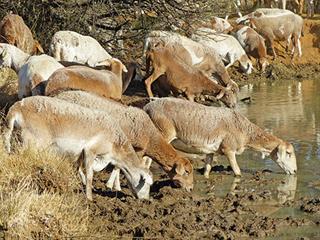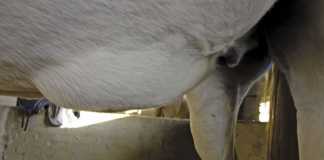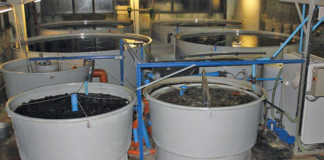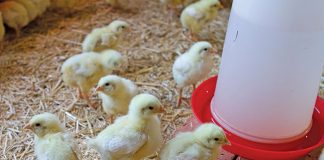
In the early 1990s, Freddie Peters of Meyerton in Gauteng put registered Ile De France ewes to Damara rams, producing hardy offspring he called the Bosrander. By the turn of the millennium, he became aware of other farmers using Damara sheep in similar breeding programmes.
Freddie subsequently became a central figure in the development of South Africa’s Meatmaster sheep breed, and published a book on the subject: Meatmaster Sheep: Breed Establishment in South Africa. It is a testament to Freddie’s leading role in the development and eventual recognition of the Meatmaster in South Africa in 2009.
READ: Breeding well-balanced Meatmaster sheep
Having grown up on a small farm near Meyerton in Gauteng, Freddie had a natural interest in animals. By the 1970s, he had developed a passion for part-time sheep breeding that first led to the development of the Bosrander in the mid-1990s.
From these, he developed a genetically diverse flock of Meatmasters that today enables him to farm profitably in the unforgiving Highveld environment.
Breeding the Bosrander
Freddie has never farmed full-time. A qualified engineer, he spent a large portion of his life lecturing at the University of Johannesburg, but his passion for sheep has always motivated him to experiment with breeds such as the Ile De France flock he established near Meyerton in 1982.
READ: Optimum nutrition for breeding ewes
As thieves regularly targeted these ewes during the lambing season, he decided to try sheep with a strong flocking instinct, a trait he hoped would decrease their vulnerability to theft.
After much searching, he sourced a number of indigenous fat-tailed Damara sheep from Namibia. These turned out to be so wild and wary of people that they created more problems than they solved. They ended up roaming the entire district, as far as Meyerton!

‘I grew up on a farm and was interested in animals from an early age,’ says Freddie Peters (left), seen here with fellow Meatmaster farmer Diseko Seku from Meyerton.
Resilient
In the mid-1990s, Freddie decided on a genetic compromise and put Damara rams to the Ile De France ewes. They produced what he then thought were unattractive offspring.
Nevertheless, he decided to leave the 40 to 50 lambs to their own devices on 150ha of rented land bordering the Suikerbosrand Nature Reserve. Nine months later, he rounded up the sheep and was astonished by their good condition and the fact that several ewes had lambed.
“I never had a ewe that lambed at even 12 or 13 months,” he recalls. “And they survived the jackals too.’’
Freddie was so impressed with his initial Bosrander that he decided on a long-term breeding programme based on significant genetic variation by sourcing Ile De France genetics from five unrelated flocks and Damara genetics from three unrelated flocks.
By the late 1990s, he was selecting Bosrander sheep strictly for their ability to survive and produce with only rock salt as supplement.
“I kept the Bosrander sheep under harsh conditions and selected them accordingly,” he recalls.
Establishing the Meatmaster breed
At the turn of the millennium, he met other sheep breeders with a similar appreciation for the value of crossing the Damara with breeds better known for conformation such as the Dorper, SA Mutton Merino and Van Rooy.
Like Freddie, Clynton Collett near Venterstad in the Eastern Cape had been using Damaras in a crossbreeding programme (albeit with Dorpers) since the 1990s.
In the Hopetown district of the Northern Cape, Walti Vermeulen had established a large flock of Damara, Dorper and Van Rooy crosses, while in Prieska, the late Christine du Toit had established a cross-bred flock of Damara and Mutton Merinos.
According to Freddie, the vision shared by these breeders created the possibility of developing a recognised composite breed defined by Damara genetics.
Central to this would be the establishment of breed standards, and the development of a uniform breeding strategy.
Clynton Collett went on to play a central role in defining these standards, convincing 12 breeders to establish the Meatmaster Sheep Breeders’ Society of South Africa (MSBSSA) in early 2005. The first MSBSSA council included Clynton Collett (president), Christine du Toit (vice-president) and Freddie Peters (secretary).
READ: Allow nature to select your best performing animals – Clayton Collette
Official recognition
From 2005 onwards, Freddie played a significant role in getting the Meatmaster officially recognised.
Eventually, on 25 May 2007, the Meatmaster was gazetted as a newly developing breed. Eighteen months later, the MSBSSA was gazetted. And on 2 October 2009, the Meatmaster breed was re-proclaimed in the Government Gazette as a “locally adapted and regularly introduced breed”.
The Meatmaster had been demonstrated as the ultimate veld sheep breed, proven to outperform its parent breeds and requiring minimum inputs while ensuring maximum profit. These attributes, and its official recognition, attracted significant attention from farmers.
By the end of 2009, MSBSSA membership had increased to 66 and is today well over 100. Meatmaster-type sheep have also become increasingly popular in Australia.

Meinfred Meatmaster ewes lamb at least once a year, and up to 40% of them bear twins.
The development of Meinfred Meatmasters
According to Freddie, his Bosrander sheep, already adapted to the rugged and bushy Suikerbosrand, formed the perfect base from which to develop his future Meinfred Meatmaster flock.
By 2005, he was using genetics from the well-respected Collett Farming CC Meatmaster flock, including rams such as CRC 0025 (top-priced Meatmaster ram in South Africa in 2005) and CRC 6165 (top-priced Meatmaster ram in South Africa in 2008).
Meinfred Meatmasters require minimal management, as selection is based on their ability to survive on the veld at minimal cost while producing mutton for maximum profit.
Freddie explains that, as his sheep have to survive the sourveld and brutally cold winters of the Highveld, they are smaller-framed than Eastern Cape and Northern Cape Meatmasters.
Nevertheless, they are highly adapted and functional, and able to make the most of available forage, whether grass or browse.
“They can’t be large- framed as they won’t be able to sustain their body weight on the veld. The Highveld is hard country,” he explains.
Besides being occasionally treated for ticks (in summer) and internal parasites, and inoculated for pulpy kidney, Meinfred Meatmasters are left on the veld all year round with only rock salt as supplement.
Rams run all year round with the flock. With the occasional exception, all ewes lamb at least once a year while between 20% and 40% bear twins.
Some Meatmaster ewes can be productive for over a decade but most have a productive life of approximately eight years. Culls are easily sold to local meat markets.
“I always have more people who want to buy than sheep available to sell. I never have enough of them,” says Freddie.
Phone Freddie Peters on 083 521 3990 or email [email protected].
Other sources: Freddie Peters, Meatmaster Sheep: Breed Establishment in South Africa.
This article was originally published in the 11 July 2014 issue of Farmers Weekly.













